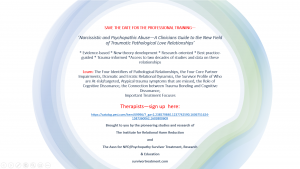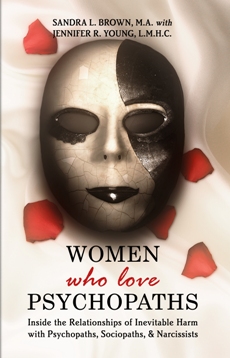In a session someone says, “I really miss what we had. I could get over this if it hadn’t been the most wonderful relationship of my life. I just feel like something has been cut out of me—like I’m missing a big part of myself now.”
Illusion is the mark of pathology. It’s why our logo is a mask, because it best represents the mirage of normalcy that pathological individuals can often project … at least for a while.
Dr. Hervey M. Checkley, a psychiatrist and writer of pathology from the 1940s, entitled his famous book, The Mask of Sanity, and tells of pathology giving all the surface signals such as having a deep connection, having the most fun ever experienced with a person, of someone who is really into you—while behind the scenes you are being used as a distraction, a paycheck, grotesquely—as a “vaginal doormat,” or some other form of “feeding” of the pathological piranha. What you are experiencing, you are internally labeling as “normal,” “wonderful,” or “love,” and yet it really isn’t any of those things. It’s just a label of experience you have tagged with him.
If someone was watching your relationship as a movie, and watched scenes in which the pathological individual is exposed for his true self, your scene would be tagged and labeled very differently by the viewer than what is labeled in your own experience. That’s because the viewer would see the pathological individual’s behaviors and words as manipulative and would have a distinctly different view of the storyline. Your labeling of your experience isn’t always accurate. As I often say, “Your thinking is what got you into this pathological relationship. Don’t always believe what you think.”
Being invested in being correct is part of the human condition and is, in part, the way our brains work. The more important the questions are—“Does he love me?” “Is this the one?”—the greater the pleasure will seem from labeling the experience as positive. The more positive the relationship is perceived, the more invested you will be to label the experiences and his behavior as positive, and to get the reward of your label, whether it is of him, the marriage, or the relationship. Of course, none of this is problematic, except if you have misread the illusion, believed the presented mask, and labeled an experience with a narcissist, anti-social, or socio/psychopath as “positive.”
The illusion:
- He was normal.
- He was in love with you.
- He was what he said he was.
- He did what he said he did.
In pathology, that’s never the case, because:
- They are mentally disordered (which isn’t normal).
- Their attachments are shallow (which isn’t love).
- They never present themselves as disordered, sexually promiscuous, and incapable of love (so he isn’t what he said he is).
- They harbor hidden lives filled with other sex partners, hook-ups, criminality, or illegal and immoral behavior (so he doesn’t disclose what he’s really up to).
What you had (that you can’t possibly miss) is a pathological relationship. What you want and miss is the ability to wrap yourself up in the illusion like a blanket—to go back to the time before you knew this was all illusion.
Women often say, when they try to break off the relationship, they have the feeling that something is being cut out of them. They feel like they are missing a part of themselves. This sensation is similar to what is called phantom limb pain, which is a medical mystery of sorts. When a person has an arm that has been amputated, the portion of the brain that used to receive sensory messages about the existing arm goes through a series of changes. This causes it to misread the brain message and creates the “ghostly” illusion that the arm is still there and in pain. Even though the patient can see that the arm is gone, and what they are experiencing is an illusion; they can’t stop the distressing phantom limb sensations of wanting to believe the arm is still there. The arm is in pain, but the arm is gone. Amputees must learn to cope differently and begin to re-label the experience they are having that the presence of the arm is a perceptual illusion.
So it is with those leaving the illusion of the pathological relationship. The emotional pain you experience is based on the illusion the pathological presented, a perceptual illusion that was mislabeled, experienced as positive, and invested in. Keeping that positive illusion is initially important to you. Learning to adjust the cognitive dissonance (which is the ping-ponging between thinking “he was good/he was bad”) is the challenge in overcoming the ghostly emotional baggage of phantom relationship pain.
(**If we can support you in your recovery process, please let us know. The Institute is the largest provider of recovery-based services for survivors of pathological love relationships. Information about Pathological Love Relationships is in our award-winning book, Women Who Love Psychopaths, and is also available in our retreats, 1:1s, or phone sessions. See the website for more information.)
© www.saferelationshipsmagazine.com






